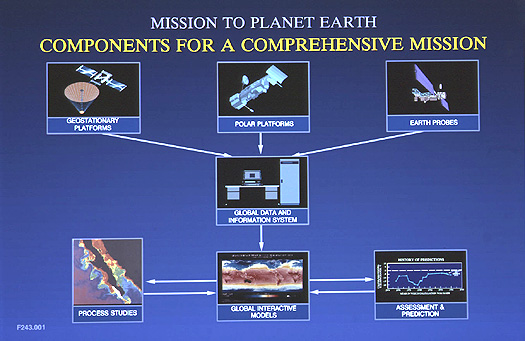Earth Science Enterprise = Mission to Planet Earth¶
Contents
NASA has been a key player in the ESS programs. It initially defined its program under the title “Mission to Planet Earth”. Several years ago that was renamed the “Earth Science Enterprise”. A diagram depicts the broad conceptual structure of this ESE. Its principal endeavor is contained in the mission-oriented EOS (Earth Observing System) and the data handling component known as EOSDIS.
Earth Science Enterprise = Mission to Planet Earth¶
ESE and its components are not science and/or technology missions per se, but rather, they comprise missions that use science and technology to give planners, policy-makers, and decision-makers the tools they need to understand our planet and to manage its resources appropriately. This idea brings a human dimension into the process, i.e., not only what is the role of humans in accelerating global change, but how does global change affect humans?
` <>`__16-15: In the above diagram, there is one key element that is the potential “bottleneck” or rate-controlling process. Make a stab at what that component of the entire MPTE program might be, and why? `ANSWER <Sect16_answers.html#16-15>`__
ESE includes flying current satellite missions, developing new missions , planning future missions, managing and analyzing satellite and in situ data, and continuing a basic research program focused on process studies, modeling, and data analysis. The space-based component of ESE is a constellation of satellites to monitor Earth from space. Sustained observations allow researchers to monitor Earth’s climate variables over time to identify trends. However, space-based monitoring alone is not sufficient. A comprehensive data and information system, a community of scientists performing research with the data acquired, and extensive ground and airborne campaigns are all important components. More than any other factor, the commitment to make Earth-science data easily available to the research and user community is critical to mission success.
To address the need for quantitative analysis of Earth and its various subsystems, ESE’s principal element, the Earth Observing System (EOS) provides systematic, continuous observations from low Earth orbit. In so doing, EOS creates an integrated scientific observing system to foster multidisciplinary study of Earth’s critical, life-enabling, interrelated processes involving the atmosphere, oceans, land surfaces, and polar regions, and the dynamic and energetic interactions among them. It also develops a comprehensive data and information system (EOSDIS), including a data retrieval and processing system, to serve the needs of scientists contributing to an integrated, multidisciplinary study of planet Earth. It also supports the overall USGCRP by acquiring and assembling a global database of remote-sensing measurements from space, in keeping with the research priorities listed above.
After scientists determine the specifics of the kinds of measurements they must make to address the many questions we face, we have to translate those requirements into a means of obtaining those measurements. This process results in a sensor design, that is, an electronic or optical-electronic device that makes the necessary measurements. Such devices require a great deal of supporting hardware, including physical support structures, power assemblies, data storage, data transmission, calibration, and more. Constraints on many of these come from cost and time, but other matters arise, such as the spacecraft size, power, and data transmission resources available (see below). In addition, if other instruments fly in concert with a primary instrument (as is often the case), we must address fields-of-view and other, interrelated considerations.
` <>`__16-16: Before reading ahead, make an educated guess as to what types of sensors might be prime candidates for the EOS platforms to be launched. `ANSWER <Sect16_answers.html#16-16>`__
Dr. Mitchell K. Hobish, Consultant (mkh@sciential.com)
